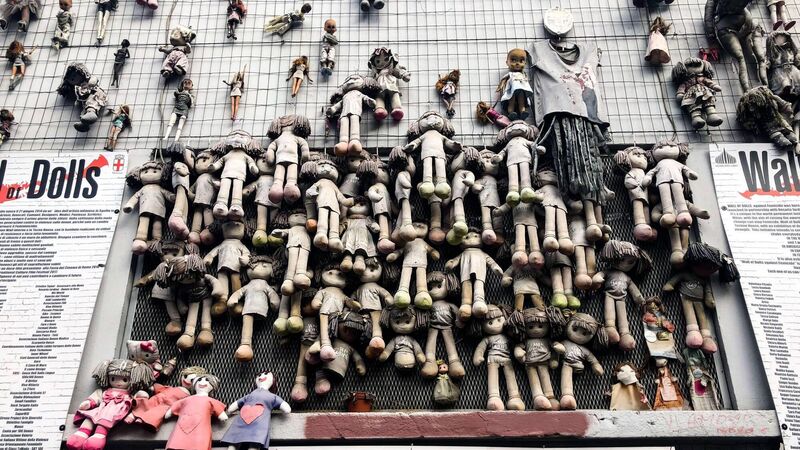Sarah Harte: Abused women and children let down by state agencies working in silos

The Wall of Dolls in Milan dedicated to victims of feminicide. The installation symbolises the suffering but also the tenacity of women. Picture: Mairo Cinquetti/NurPhoto via Getty Images
Last Wednesday on , Mary recounted to Joe Duffy how her former partner Daniel Kane was the first man in Ireland to be convicted of coercive control. He also cut her face with a pizza slicer, stamped on her head, burned her foot, and strangled her.
During the original trial, the judge noted that the accused’s senior counsel was instructed to suggest to the victim that "she was prone to hysteria". Mary did not press charges because she was afraid that nobody would believe her. The violence would have continued but for the intervention of a doctor.
Kane appealed the severity of his 10 and a half year sentence, but the Court of Appeal recently confirmed the term, finding that he had subjected Mary to a prolonged campaign of brutal physical and psychological violence, putting her in a place of fear, causing her to be submissive.
Also last Wednesday, a joint Department of Justice and National Women’s Council report was launched, revealing that securing justice remains a huge challenge for the victims of domestic and sexual violence because our systems are set up to fail them.
The revelations in the report won’t shock frontline professionals working in the field. As the report clearly sets out, we are falling down in several critical areas.
There is a system-wide lack of knowledge about the dynamics and impact of domestic abuse with victims "undermined and blamed" for remaining in homes where domestic and/or sexual violence has occurred.
The fact that victim-blaming is rife isn’t a surprise for several reasons.
There is no mandatory professional training for social workers, judges, lawyers, or court-appointed experts. It is staggering that traumatised, abused women and children are being assessed by those who lack proper training and who fail to understand the trauma resulting from domestic violence.
Guards do their own in-house training, with some receiving more training than others. And while the joint report says that gardaí in some regions are “inexplicably” reluctant to prosecute perpetrators breaching domestic abuse orders, the guards who receive "appropriate training" around domestic violence emerge well from the report. It just goes to show that specialist training works.
Without training key personnel who encounter domestic violence, victims are prey to the same myths about domestic and sexual violence as members of the wider community.
Myths or false beliefs about domestic abuse and those who suffer it are surprisingly common.
A particularly destructive myth is the assumption that a woman would leave if things were "that bad". It shows a complete lack of understanding as to how women get trapped — financially, emotionally, and psychologically — and of the "insidious" nature of the abuse.
There is also a tendency when horrible cases hit the headlines to focus on the individual facts and explain the actions of a specific abuser as a one-off. Too often the media takes the line that a good man, a pillar of the community, simply ‘lost it’ because he was under pressure.
Or conversely, they may paint a picture of a ‘monster’ rather than fronting up to the fact that the perpetrator is a flesh-and-blood man who may hold down a job, have friends, play sports, and be successful in his career.
It’s more comforting to run with the rotten-apple narrative. Recognising the misogyny that underpins domestic and sexual violence and which is woven into the fabric of our society is tough stuff.
This victim-blaming leaves victims enmeshed in our justice system, being constantly asked to prove their innocence. As a result, some victims withdraw from the system or others fail to report abuse due to the chilling effect of this victim-blaming.
Another major problem is that we lack a common approach between the various agencies, with no mechanisms to co-operate and share information. Victims of domestic or sexual violence may find themselves embroiled in two or three distinct legal processes in the criminal justice, family law, and child welfare system.
Yet, An Garda Síochána, the Courts Service, the Probation Service, and Tusla do not recognise or engage with each other. Instead, they beaver away in their silos without sharing their evidence, their knowledge, or even speaking a common language.
Women and children lost in the clashing and separate systems are subject to multiple interviews by separate agencies.
They may be left in ‘life-threatening’ situations as a result of these gaps in systems.
It also means that abusers may be freed to use the apparatus of the law to attack victims. One common example is that a man who has domestically abused his partner may use custody battles as a way to terrorise his victim and use access to children as a way to re-traumatise the victim.
The joint report recommends the setting up of formal channels between the gardaí, the courts, and the office of the Director of Public Prosecution to share information on bail, access orders, and applications. It advocates for a joint-management system for domestic violence cases so that civil and criminal proceedings can be held in tandem.
These recommendations make good horse sense. We badly need mechanisms to make interagency co-operation a reality.
Madeline McAleer, research and development director with Haven Horizons, a national domestic violence organisation that provides accredited professional training to domestic abuse professionals in collaboration with Technological University Shannon (TUS) says that such an interagency mechanism already exists elsewhere.
“The Blueprint for Safety is an American model which interlinks justice agencies, giving meticulous attention to the details of inter-agency case processing," she says. "National and international research shows that when agencies do not co-ordinate their interventions and approaches, fatal errors occur. Blueprint changes that.”
The Blueprint has been used to great effect in the States and involves greater collaboration between police, frontline domestic abuse support services, prosecution services, court services, prison, and probation services.
“It looks at the entire process, from the 999 call all the way through the courts’ system,” she says.
The biggest problem here, she says, is the lack of information-sharing between relevant agencies and a lack of training for those who work in the area.
Six years ago, the Garda National Protective Services Bureau (GNPSB) and Haven Horizons brought a delegation from the States to address national agencies and to discuss how the Blueprint model could be piloted in Clare, then rolled out nationally. Clare is well-placed to pilot such a model — it has had an interagency network in place since 1998. The model is there — why aren’t we using it?
Last year was the deadliest year for Irish women in a decade.
Gardaí released figures to show that over half of all murders in Ireland had a domestic abuse motive.
In April, they reported that domestic violence reports were already up 4% on last year. The recently published Central Statistics Office report found that 52% of Irish women had experienced sexual violence in their lifetime.
The authors of this joint report, Ellen O’Malley Dunlop and Nuala Egan, are to be commended for producing a valuable piece of research, but identifying the issues is just the first step.

Justice Minister Simon Harris has said that his department will review the recommendations contained in the report as part of the “Government’s zero-tolerance plan to tackle domestic, sexual, and gender-based violence, and the Government’s family justice strategy”.
However, joined-up thinking at a governmental level is something we are traditionally poor at in Ireland.
The question is whether we have what it takes to connect the dots and implement proper systems and training, allowing us to properly respond to the scourge of domestic and sexual violence.














